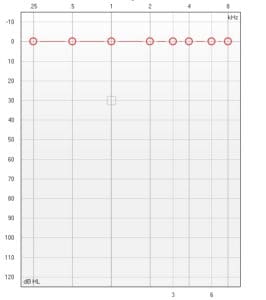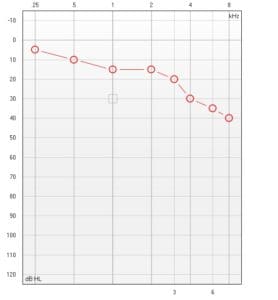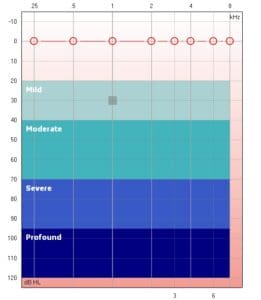What is normal hearing?
As audiolgists, we often talk of normal hearing. What do we mean by this and is there even such a thing? As with most things in life, the answer is not straightforward, however we will explore this briefly today. Measures of human form and function are typically averaged to allow us to compare between individuals. It’s the same for hearing. At the most basic level, we hear different pitches of sound (frequencies) which are measured in Hertz. Typically at birth, babies can hear from 20 Hz up to 20,000 Hz (20 kHz). We also hear a range of loudness of sounds, from barely detecatable to the most intense sounds like thunder. A special loudness scale was developed (the decibel scale) to allow us to measure and discuss different levels of loudness. Leaving out the complicated mathematics, we have a dB Hearing Level scale (dB HL) which is used on audiograms (hearing measurement charts) to plot how well we can hear.
Normal hearing
In order to establish what normal hearing is, several studies took a group of young adults with no prior ear related problems and measured the quietest sounds they could hear at all the important frequencies which are necessary to understand speech. This average level is 0 dB HL and on an audiogram is at the top of the chart. Thus, a typical young adult with no history of ear problems or noise exposure, should on average, be able to hear all the important frequencies at 0 dB HL. There is always a ‘spread’ around the average and thus if someone can hear at 15 dB HL or below, they are said to have normal hearing.
 So, we have a reference level of 0 dB HL, which we can then compare someone else’s hearing to. Now they may be of a similar age or older, they may have had ear problems or have been exposed to excessive levels of noise or developed hearing loss with age. All of these will impact a person’s level of hearing. Below is a typical audiogram from a 60 year old with hearing loss mainly in the higher frequencies. The different speech sounds are also plotted on the audiogram to give an example of which sounds can be heard and which cannot (p, h, g, ch, k, f, s, th).
So, we have a reference level of 0 dB HL, which we can then compare someone else’s hearing to. Now they may be of a similar age or older, they may have had ear problems or have been exposed to excessive levels of noise or developed hearing loss with age. All of these will impact a person’s level of hearing. Below is a typical audiogram from a 60 year old with hearing loss mainly in the higher frequencies. The different speech sounds are also plotted on the audiogram to give an example of which sounds can be heard and which cannot (p, h, g, ch, k, f, s, th).
 But we may ask, is this hearing normal for a 60 year old? Well, further studies have measured average hearing levels at different ages (30, 40, 50, 60, 70, 80). It turns out that the average hearing level for a 60 year old is better than in the example above. See the audiogram below.
But we may ask, is this hearing normal for a 60 year old? Well, further studies have measured average hearing levels at different ages (30, 40, 50, 60, 70, 80). It turns out that the average hearing level for a 60 year old is better than in the example above. See the audiogram below.
 In fact, as we age, the differences in hearing level between individuals gets bigger. Some 70 year old’s have extremely good hearing, with some having severe lossess. The terms, mild, moderate, severe and profound are used to describe the level of hearing loss found (see below).
In fact, as we age, the differences in hearing level between individuals gets bigger. Some 70 year old’s have extremely good hearing, with some having severe lossess. The terms, mild, moderate, severe and profound are used to describe the level of hearing loss found (see below).
 Putting all the above together, when someone says they can hear, but they struggle to hear clearly, or feel that people are ‘mumbling’, they probably have good hearing in the low frequencies and not so good hearing in the high frequencies. As we age, hearing problems are more common, however if you feel that you are not hearing clearly, it may be time to get your hearing tested or at least assessed to see if earwax may be causing a problem, see – Earwax removal
Paul at ‘The Hearing Space’ has years of experience. Contact
T: 0113 8730444
E: hello@thehearingspace.co.uk
Putting all the above together, when someone says they can hear, but they struggle to hear clearly, or feel that people are ‘mumbling’, they probably have good hearing in the low frequencies and not so good hearing in the high frequencies. As we age, hearing problems are more common, however if you feel that you are not hearing clearly, it may be time to get your hearing tested or at least assessed to see if earwax may be causing a problem, see – Earwax removal
Paul at ‘The Hearing Space’ has years of experience. Contact
T: 0113 8730444
E: hello@thehearingspace.co.uk
 So, we have a reference level of 0 dB HL, which we can then compare someone else’s hearing to. Now they may be of a similar age or older, they may have had ear problems or have been exposed to excessive levels of noise or developed hearing loss with age. All of these will impact a person’s level of hearing. Below is a typical audiogram from a 60 year old with hearing loss mainly in the higher frequencies. The different speech sounds are also plotted on the audiogram to give an example of which sounds can be heard and which cannot (p, h, g, ch, k, f, s, th).
So, we have a reference level of 0 dB HL, which we can then compare someone else’s hearing to. Now they may be of a similar age or older, they may have had ear problems or have been exposed to excessive levels of noise or developed hearing loss with age. All of these will impact a person’s level of hearing. Below is a typical audiogram from a 60 year old with hearing loss mainly in the higher frequencies. The different speech sounds are also plotted on the audiogram to give an example of which sounds can be heard and which cannot (p, h, g, ch, k, f, s, th).
 But we may ask, is this hearing normal for a 60 year old? Well, further studies have measured average hearing levels at different ages (30, 40, 50, 60, 70, 80). It turns out that the average hearing level for a 60 year old is better than in the example above. See the audiogram below.
But we may ask, is this hearing normal for a 60 year old? Well, further studies have measured average hearing levels at different ages (30, 40, 50, 60, 70, 80). It turns out that the average hearing level for a 60 year old is better than in the example above. See the audiogram below.
 In fact, as we age, the differences in hearing level between individuals gets bigger. Some 70 year old’s have extremely good hearing, with some having severe lossess. The terms, mild, moderate, severe and profound are used to describe the level of hearing loss found (see below).
In fact, as we age, the differences in hearing level between individuals gets bigger. Some 70 year old’s have extremely good hearing, with some having severe lossess. The terms, mild, moderate, severe and profound are used to describe the level of hearing loss found (see below).
 Putting all the above together, when someone says they can hear, but they struggle to hear clearly, or feel that people are ‘mumbling’, they probably have good hearing in the low frequencies and not so good hearing in the high frequencies. As we age, hearing problems are more common, however if you feel that you are not hearing clearly, it may be time to get your hearing tested or at least assessed to see if earwax may be causing a problem, see – Earwax removal
Paul at ‘The Hearing Space’ has years of experience. Contact
T: 0113 8730444
E: hello@thehearingspace.co.uk
Putting all the above together, when someone says they can hear, but they struggle to hear clearly, or feel that people are ‘mumbling’, they probably have good hearing in the low frequencies and not so good hearing in the high frequencies. As we age, hearing problems are more common, however if you feel that you are not hearing clearly, it may be time to get your hearing tested or at least assessed to see if earwax may be causing a problem, see – Earwax removal
Paul at ‘The Hearing Space’ has years of experience. Contact
T: 0113 8730444
E: hello@thehearingspace.co.uk
